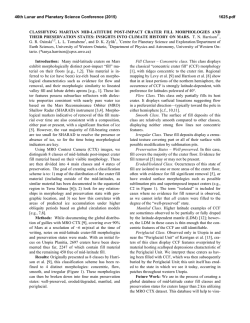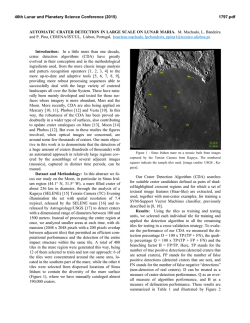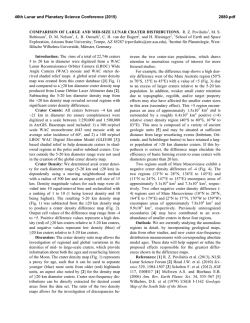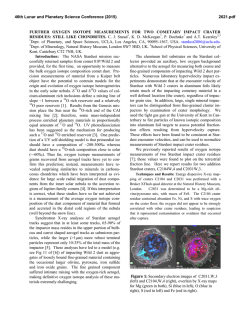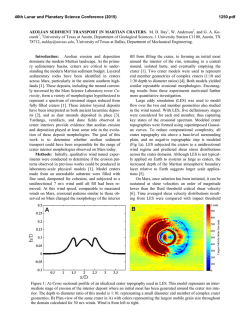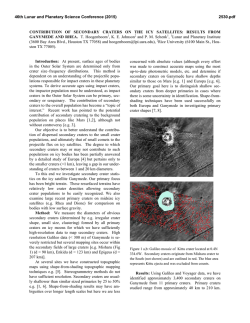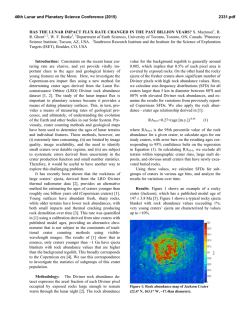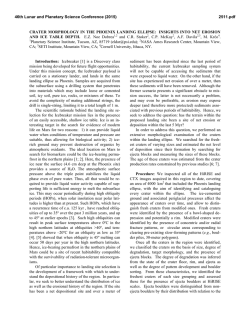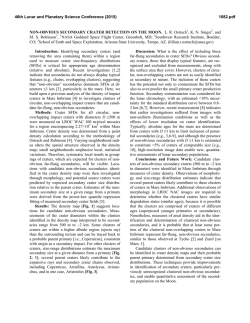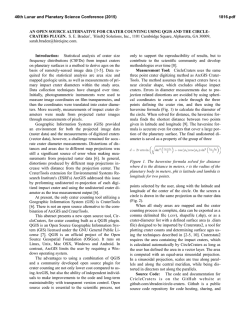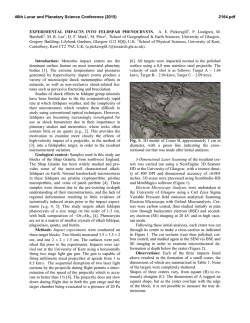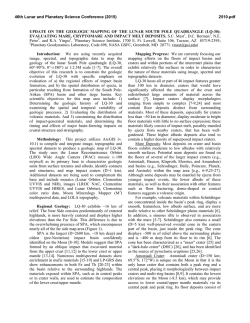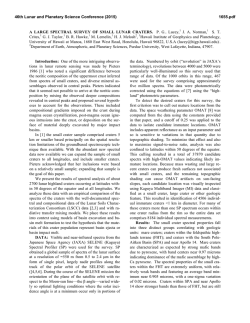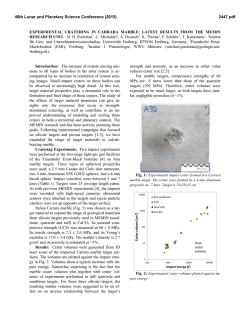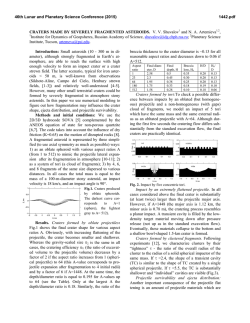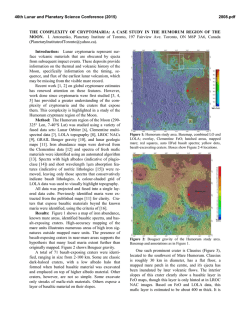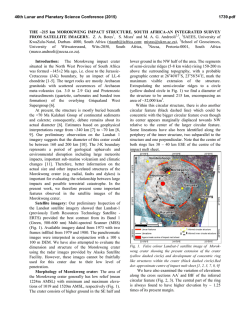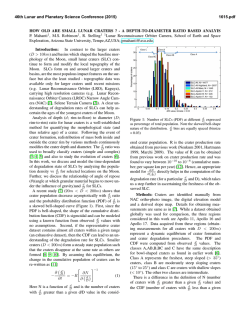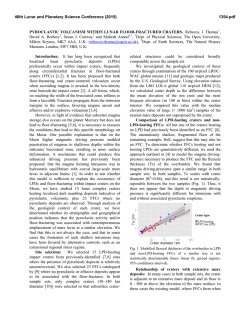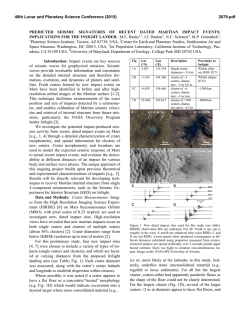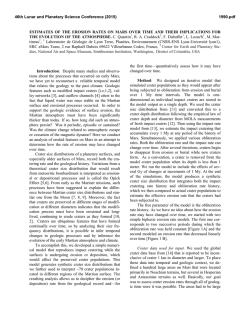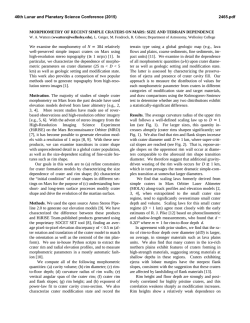
AUTOMATED CRATER DETECTION IN IMPACT BASINS ON
46th Lunar and Planetary Science Conference (2015) 2786.pdf AUTOMATED CRATER DETECTION IN IMPACT BASINS ON MERCURY SURFACE. M. Pedrosa1, P. Pina2, M. Machado2, L. Bandeira2 and E. A. Silva1, 1FCT, UNESP, Presidente Prudente, BRAZIL ([email protected], [email protected]), 2CERENA, Instituto Superior Técnico, University of Lisbon, PORTUGAL ([email protected], [email protected], [email protected]). Introduction: In the last decade, many researchers have been working for the development of crater detection algorithms (CDAs) on remotely sensed imagery on a wide variety of planetary surfaces, although the large majority of them only deal with the surfaces of the Moon and Mars due to the huge amount of imagery available for theses planets. On the other hand, just a couple of years ago we had the opportunity to depeen our knowledge about the Mercury planet. Until 2004, only 45% of Mercury surface had been covered by probe Mariner. Images from all the surface have been provided only after the insertion in orbit of the probe MESSENGER. Because of this, the impact craters catalogues available for Mercury are quite recent, generated manually, and only contain craters larger 10 km [1] and 20 km [2]. The automated identification of the craters of Mercury is even more recent [3, 4, 5]. Therefore, in this work we decided to depeen the preliminary investigations by testing our methodology in some of Mercury’s basins. Method: The detection method we are applying now is the same adaptive one that was inspired by two previous works [6][7] and sucessfully put together into a single processing sequence [8], which achieved relevant crater detection performances on Mars [9], Phobos [10] and the Moon [11]. We briefly remind that it consists of sequentially finding regions of the image that are good crater candidates (in order to substantially reduce the amount of information to analyse), on extracting a set of image characteristics (named Haarlike features) describing these candidates and also of some non-candidate samples, which are then classified into crater or non-crater with the aid of a robust classifier, Adaboost or SVM-Support Vector Machine. Since normally both perform equally well, we have now opted for the SVM classifier due to its faster computational time. Dataset: To test the performance of our CDA we chose three craters with few hundreds of kilometers in diameter (Rachmaninoff, Mozart and Raditladi). Rachmaninoff, Mozart and Raditladi basins are peak-ring craters with 290 km, 225 km and 263 km in diameter, respectly. The images were all obtained by the MDIS-NAC camera, on board the MESSENGER probe. These images are narrow-angle and own medium resolution: varying in 100 - 125 m/pixel for Rachmaninoff, 206 - 236 m/pixel for Mozart and 261 m/pixel for Raditladi. Although there are images with better resolution, we using images with medium resolution because they cover all of the three craters. Using geographic information we building the mosaics for each basin which were perfomed with ISIS software from USGS [12]. The mosaic generated contains the initial characteristics of each individual image, preserving the contrast and spatial resolution. Thus, we use overlapping raw images acquired along different orbits to make the registering and geometric corrections (Figure 1). Results: The objective of our CDA is to automatically survey craters between a minimum diameter of 10 pixels and the maximum crater diameter present in the images. This means that craters with 1250m can be detected in Rachmaninoff crater. The experimental part was developed in the following way: for each crater, the training phase was performed with the image with the best resolution, while the testing phase was peformed with the model obtained on the others images of each crater. The performances obtained are shown in Table 1. The comparion between the outputs of the algorithm and the ground-thuth was measured by detection percentade D = 100 x TP/(TP+FN), the quality percentage Q = 100 x TP/(TP + FP + FN) and the branching factor B = FP/TP. where, TP is the number of true positives (detected craters that are craters), FP is the number of false positives (detected craters that are not), and FN stands for the number of false negatives (non-detected crates). Table 1 – Crater detection performances per basin D (%) Q (%) B Rachmaninoff 95 74 0.29 Mozart 82 62 0.39 Raditladi 85 56 0.60 The overall results can be considered good, although the result of each basin varies, as can be seen in Table 1. The better results are from Rachmaninoff basin which own better resolution. Conclusions: The performance of the CDA shows that besides presenting good results in surface as Mars, Moon and Phobos, it can be successful applied in Mercury surface. The results are consistent with the several resolutions or scales. Currently, our approach has relevant rate of correct detection, but the rate of false detection can be better. We also intend to greatly 46th Lunar and Planetary Science Conference (2015) enlarge the dataset of images from Mercury to improve our algorithms and the performances, encompassing all types of terrains and crater dimensions. References: [1] Herrick et al. (2011), Icarus, 215: 452-454. [2] Fassett et al. (2011), GRL, 38: L10202. [3] Salamuniccar G (2013) LPS XLIV, Abstract #1866. [4] Pedrosa et al. (2014) LPS XLV, Abstract #2472. [5] Pedrosa et al. (2014) EPSC IX, Abstract 2786.pdf #546. [6] Martins et al. (2009) IEEE GRSL, 6: 127131. [7] Urbach E. and Stepinski T. (2009), PSS, 57: 880-887. [8] Bandeira et al. (2012) ASR, 49: 64-74. [9] Bandeira et al. (2013), AGU Fall Meeting, ID 1796317. [10] Salamuniccar G. et al. (2014), ASR (in press). [11] Machado e al. (2015) this volume. [12] Torson, J. and K. Becker (1997), LPS XXVIII, Abstract #1443. (a) (b) (c) Figure 1. Mosaic of images of MDIS-NAC camera from MESSENGER probes and their respectively crater detection example. (a) Rachmaninoff, (b) Mozart and (c) Raditladi. The yellow circles are delimiting the region of study. TP are represented in green, FP in red and FN in blue. [Image credits: MESSENGER MDIS NAC]
© Copyright 2025
